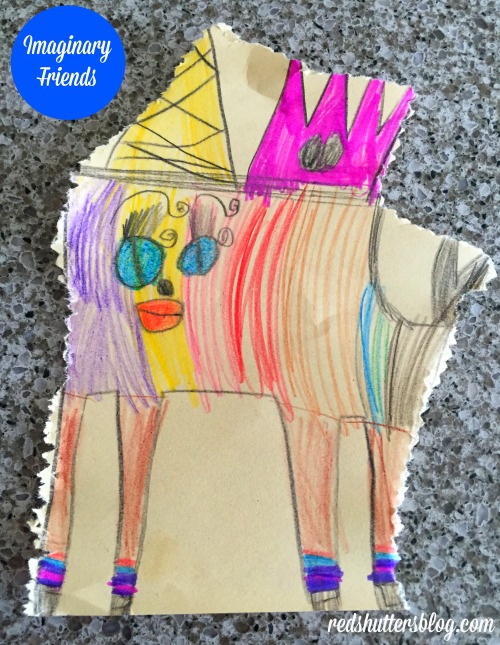When I was a kid, I had an imaginary friend named Elizabeth. She lived in a brownstone in New York City, not unlike the houses on Sesame Street, with her four brothers and sisters and her parents. Elizabeth and I had many, long conversations about life: she’d tell me about the adventures her family experienced—an urban Swiss Family Robinson—while I told her all about life in the suburbs. I don’t remember when she stopped being a fixture in my life, but, during those early years, she was a dear and close friend.
I was pleasantly surprised then, when, a few months ago, my kids started talking about their imaginary friends. I researched it a bit and found writing (including this post) that indicated having imaginary friends is a healthy part of childhood. So, I’ve embraced this latest development in raising kids, encouraging R and G to write and tell stories about their imaginary friends.
Since these are the sorts of memories parents forget as their children age, and since I was fascinated by the creatures my kids had come up with, I decided to interview R and G for Red Shutters about their imaginary friends. G went first.
G explained that her imaginary friend, a rainbow unicorn, named Lily is two-and-a-half years old and lives with us in our house. Lily is magical and can turn G into a fairy whenever she wants. Lily tells G secrets about fairies that G cannot tell anyone else.
Lily sleeps with G in her bed at night and “does not snore.” Her favorite food is G’s nose. “Wait, no,” G corrected. “Her favorite food is nothing; she doesn’t eat anything.”
While G is at school, Lily plays with the other friends who live in G’s room: her stuffed animals, called “loveys,” Princess Leia (a lavender unicorn), Share (a Care Bear), and Octopus (a pink dolphin).
As I interviewed G for this post, Lily, she explained, was sitting on her head. G then stretched out her arms to about three feet wide to show how big Lily was.
After all of her explanations, G said, “Actually, Lily is a cat. She can turn herself into a cat. You want to see her?”
“Yes,” I replied eagerly.
“Do you want to see her change back into a unicorn?” she asked.
As I nodded, she changed her mind. “Well, I’m not really sure you can.” And then she skipped away.
R’s interview was next, and he was happy to talk about his imaginary friends—emphasis on the plural.
“One is a Komodo dragon named Freddy. Another is a dog named Max. The last one is a lizard and his name is…” he paused while he considered his options. “His name is Frank.”
I inquired about their activities while he’s at school. He promptly answered, “They sleep with my snugglies (his stuffed animals). They eat. The Komodo dragon eats gazelles. The dog usually eats dog food. And the lizard… I leave him a surprise lunch. It’s usually bugs, flower nectar, or worms. Today, I’m trying out something new with him; I am going to give him fruit.”
“They fight each other sometimes but the Komodo dragon never bites,” he continued. “When I come home, they run up and they lick me. When I am asleep, they sort of tickle me with their tails. The dog licks my face.” He giggled, his face shining with happiness, and then he demonstrated how Frank licks him, laughing even harder.
“I give them dinner usually. I give them vegetables, lots of vegetables. The Komodo dragon is 25 feet long because I gave him so many vegetables. The dog is 19 feet, and the lizard is—how long is this?” he asked, holding up a piece of paper.
“About a foot,” I replied.
“The lizard is about a foot,” he said with a nod of his head.
“Why do have you three imaginary friends?” I asked.
“Because I like them!” he said, as if the answer should have been obvious. And then he went back to his Legos.
While Lily doesn’t have any siblings, she does play with R’s imaginary friends, her pseudo brothers, though R denies any interaction between the imaginary residents of our home. (“My imaginary friends don’t like unicorns,” R explained emphatically. “Plus they are too busy to play.” Doing what? I am not sure; perhaps eating gazelles.)
R and G understand that Lily, Freddy, Max, and Frank aren’t real. They enjoy incorporating these friends in their playtime and make believe games, and I enjoy watching their brains at work, creating and imagining. If R starts asking me to buy dog food… well, then, I may rethink this!


So great. Max used to have an assortment of friends too, Ani Mohshi and Dubar Enzo among them. They worked in an office with a lot of ketchup. 🙂